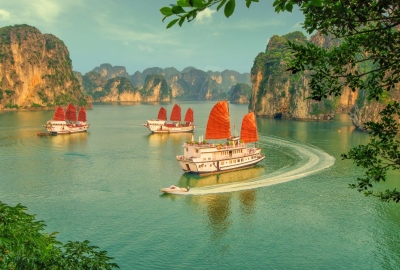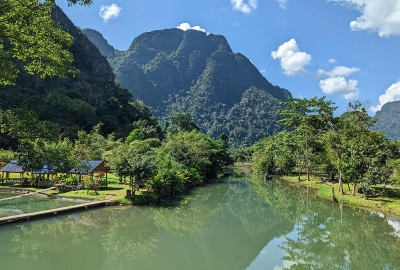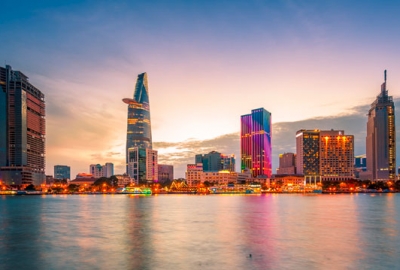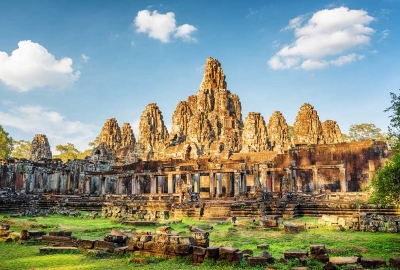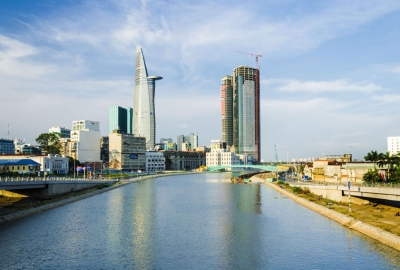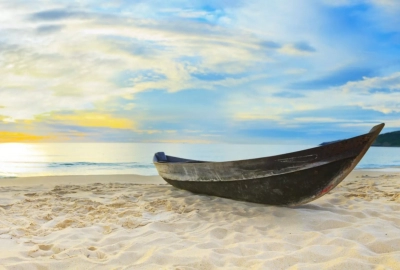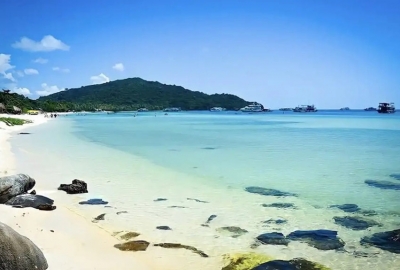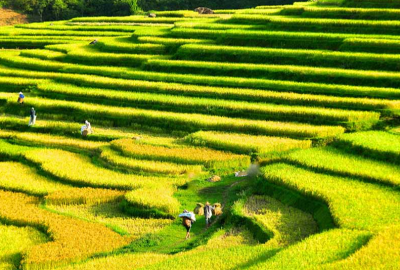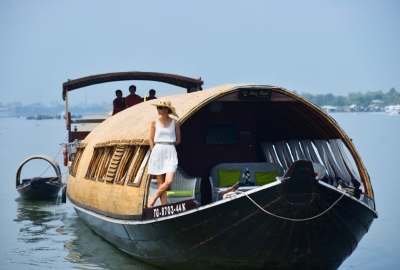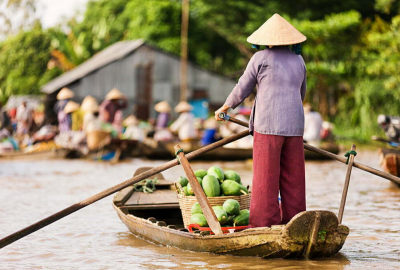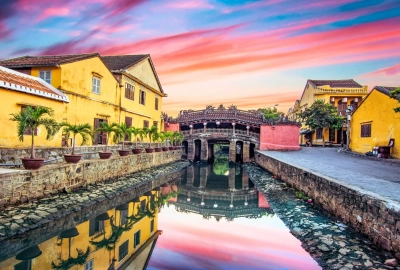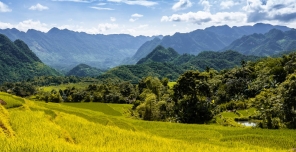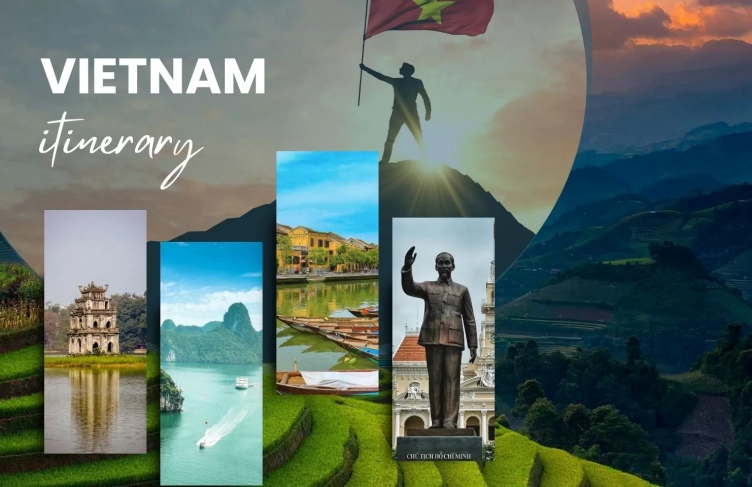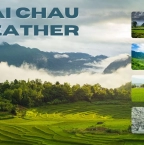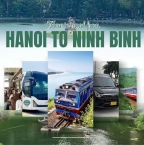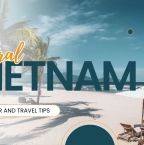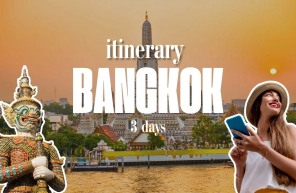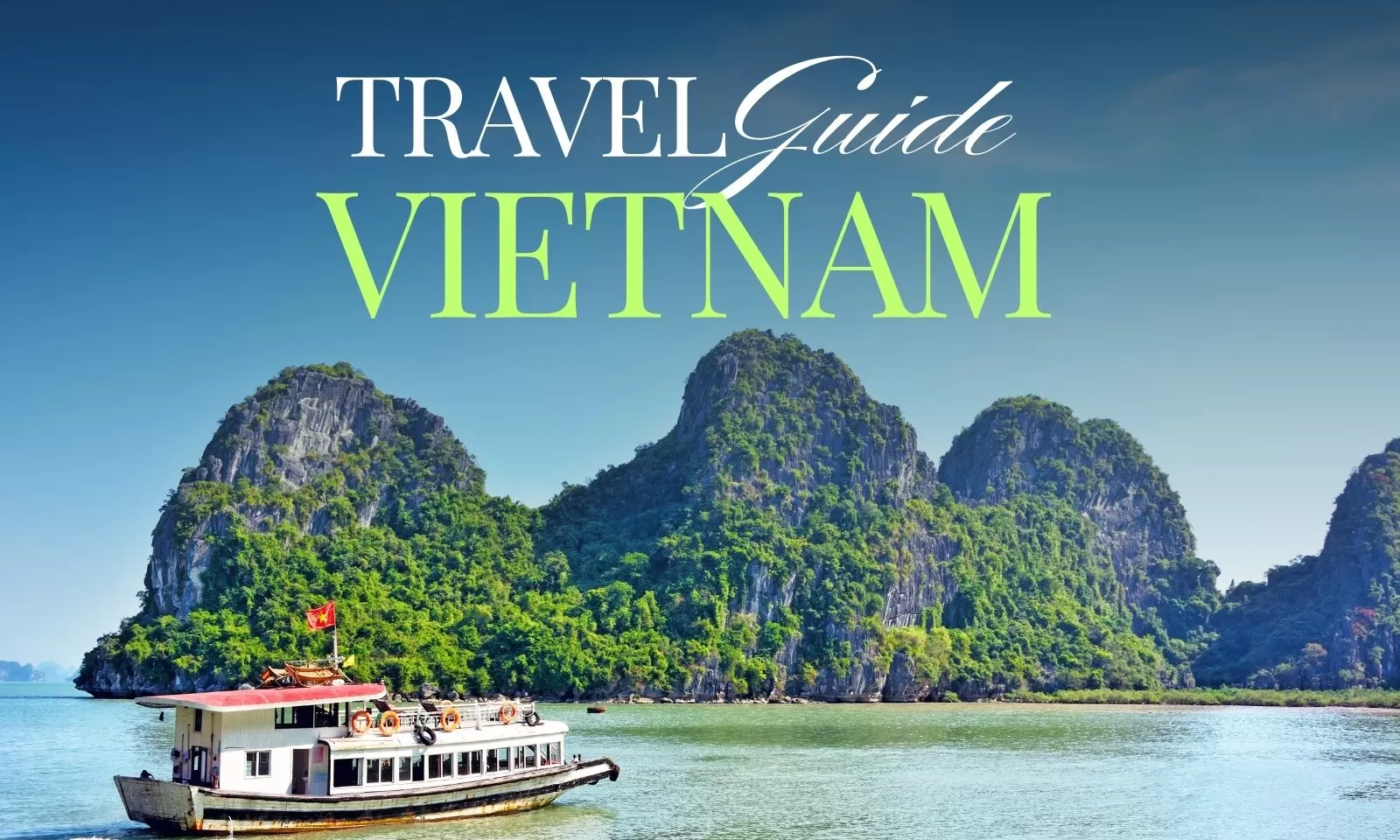
Vietnam Travel Guide: Things To Know Before You Go

Organizing a journey far from your residence, especially on the other side of the globe, can be an intimidating task. But don’t worry, continue reading and discover the ultimate Vietnam travel guide to help you make the most out of your visit to our beautiful country
In this article, we will provide you all the information you need to know before traveling to Vietnam: What to prepare? What to do in Vietnam? Where to stay? What to eat? And now, here we go!
Table of Contents
Vietnam travel guide: Prepare before you go
This Vietnam travel guide will help you get ready with all the essentials before your journey begins. From understanding Vietnam visa requirements, keeping up with health and vaccination needs, managing money and currency exchange, to packing the right clothing for the weather, this guide ensures you are well-prepared for a smooth and memorable adventure.
Vietnam visa requirement
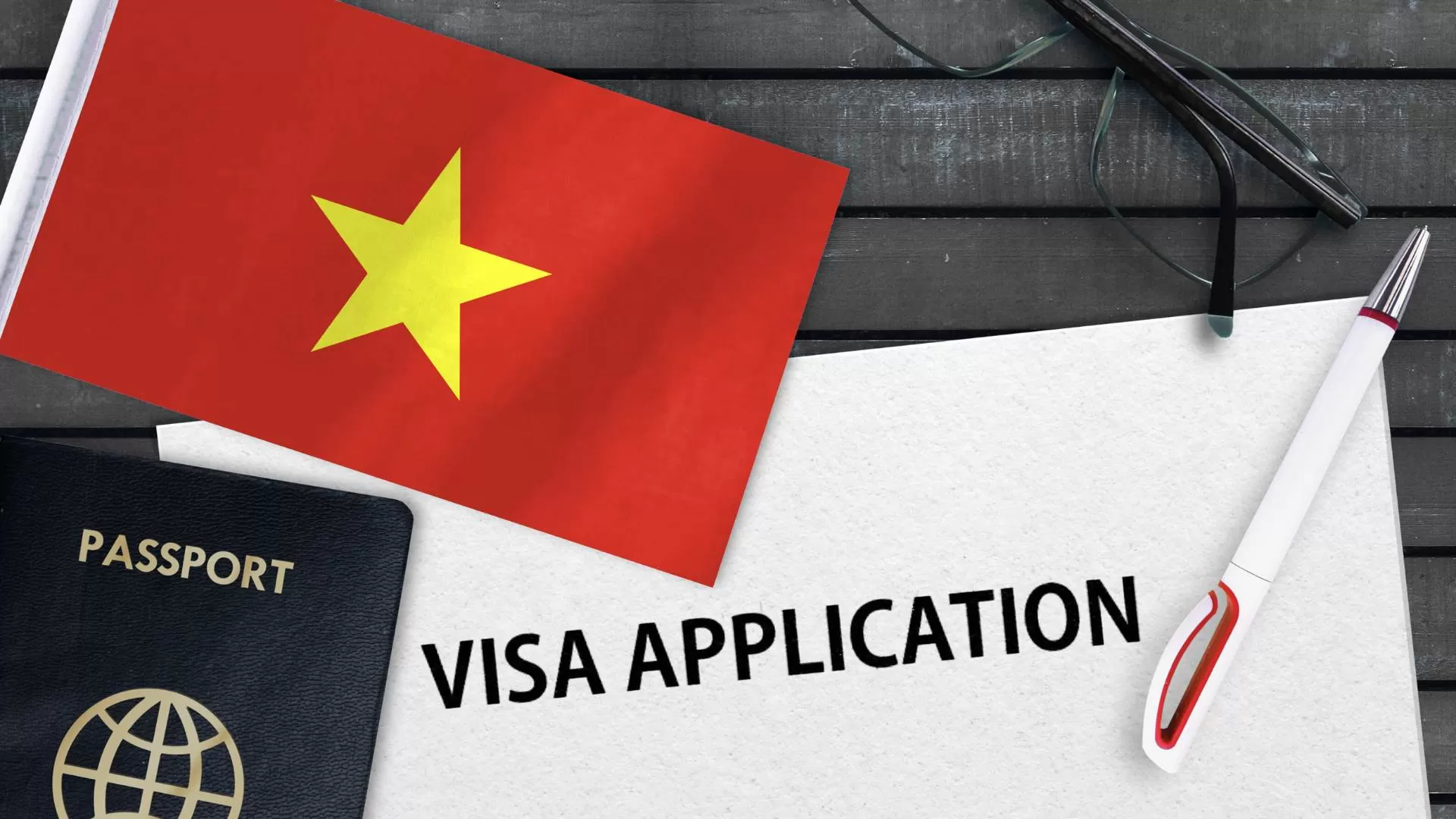
When finding the best Vietnam travel guide, one can not neglect the visa application process. Here is some help! There are several ways to apply for a visa to enter Vietnam:
Online: You can apply for an e-Visa to Vietnam through the Vietnamese immigration website, which allows you to complete the process online and receive your visa electronically.
Embassy or Consulate: You can apply for a visa through the Vietnamese embassy or consulate in your home country by submitting the required documents in person or by mail
Travel agent: You can also use the services of a travel agent, who can assist with the visa application process and handle the required paperwork on your behalf.
There is the list of countries that can enter Vietnam without applying for a visa beforehand. You can check the Ministry of Foreign Affairs website for any news on Vietnam visa as well for your specific country.
Health and vaccination
To make the most of your journey, this Vietnam travel guide suggests preparing carefully for your health before departure. While there are no strict vaccination requirements for entry, taking precautions will help you travel with peace of mind.
Recommended vaccinations and health tips:
Routine immunizations: Ensure you are up to date with MMR, diphtheria, tetanus, and polio.
Hepatitis A & B: Advised for all travelers, as these can be contracted through food, water, or close contact.
Typhoid: Recommended if you plan to eat local street food or visit smaller towns.
Japanese Encephalitis: Important for those staying long-term in rural areas or visiting during rainy season.
Malaria precautions: Consider preventive medication if traveling to remote highland or forest regions.
Mosquito protection: Bring insect repellent to guard against dengue fever and other mosquito-borne diseases.
Prescription medicine: Carry enough supply, as some drugs may be hard to find locally.
In any case, before leaving for Southeast Asia, we advise you to inform your doctor, who will provide you with the most appropriate recommendations for your state of health.
Money and currency exchange
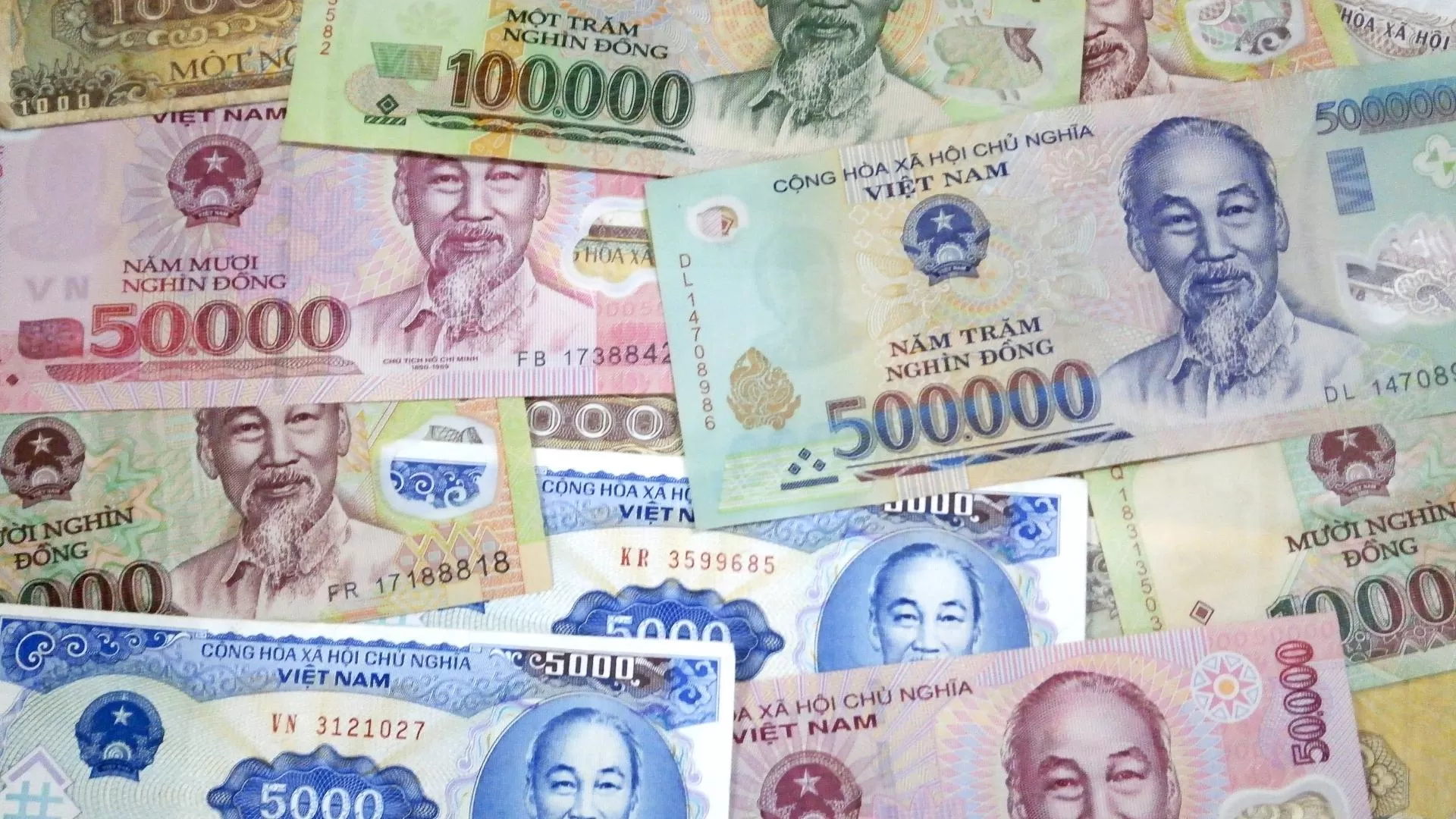
The official currency in Vietnam is the Vietnamese Dong (VND). Travelers should better exchange some money into the local currency before arriving in Vietnam.
Here are some options for exchanging money in Vietnam:
Banks: Most major cities in Vietnam have international banks that offer currency exchange services. You can expect to get a good exchange rate and incur relatively low fees.
Currency exchange offices: You can find currency exchange offices in tourist areas and major airports. The exchange rates may be slightly less favorable than at banks, and the fees can be higher.
ATMs: ATMs are widely available in major cities and tourist areas in Vietnam, and you can use your credit or debit card to withdraw local currency. Some ATMs may charge a foreign transaction fee, so check with your bank before traveling.
It’s important to compare the exchange rates and fees at different banks and currency exchange offices before exchanging your money, and to keep in mind that you may need to show identification and your passport. Additionally, always count your money carefully and ask for a receipt.
You can also read more information: All about currency exchange in Vietnam: What you should know?
Vietnam weather guide
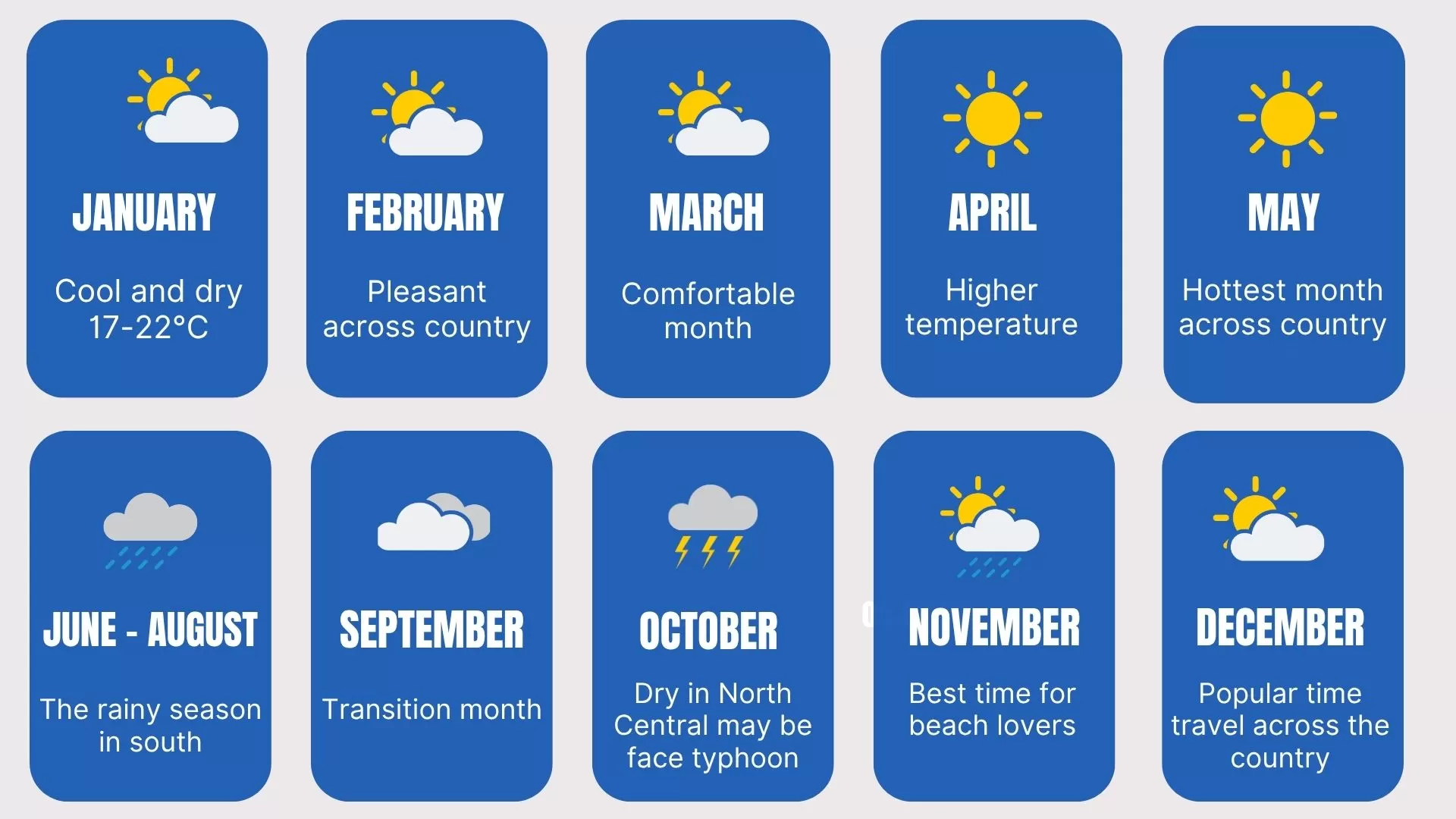
Research the climate in the regions you will be visiting and pack appropriate clothing and gear.
Vietnam has a tropical monsoon climate, with distinct wet and dry seasons. The weather in Vietnam varies depending on the region, but in general, here’s what you can expect:
North Vietnam: The north has a temperate climate with four distinct seasons: spring, summer, fall, and winter. Winter (December to February) can be cool and dry, while summer (June to August) can be hot and humid. For travelers planning to explore northern Vietnam, the best time to visit is from October to April.
Central Vietnam: The central region has a hot and dry climate, with two main seasons: dry (February to August) and wet (September to January). During the wet season, heavy rainfall and typhoons can cause disruptions. If your journey takes you to central Vietnam, the ideal travel season is from February to August
South Vietnam: The south has a tropical climate with high humidity, two main seasons: dry (December to April) and wet (May to November), and temperatures that range from warm to hot throughout the year. For those heading to southern Vietnam, the most pleasant period is from December to April
If you wish to explore all three regions of Vietnam in one journey, the most suitable time is from February to April or October to November, when the weather is generally pleasant nationwide, making it easier to enjoy both cultural sights and natural landscapes.
Regardless of the region, it’s always a good idea to check the weather forecast before traveling and pack appropriate clothing and gear, such as light and airy clothing for hot weather, rain gear for the wet season, and a light jacket or sweater for cooler weather.
You can check more information: Best time to visit Vietnam for first-time travelers
Transportation in Vietnam: How to get around
Navigating Vietnam can be an exciting part of your journey, and this Vietnam travel guide is here to help you choose the best ways to move around. From bustling cities to scenic countryside, understanding your transportation options will make your trip smoother, safer and more enjoyable.
| BEST WAYS TO GET AROUND VIETNAM |
|
For more details: Transportation in Vietnam: Best options for getting around
Accomodations options for every travelers in Vietnam
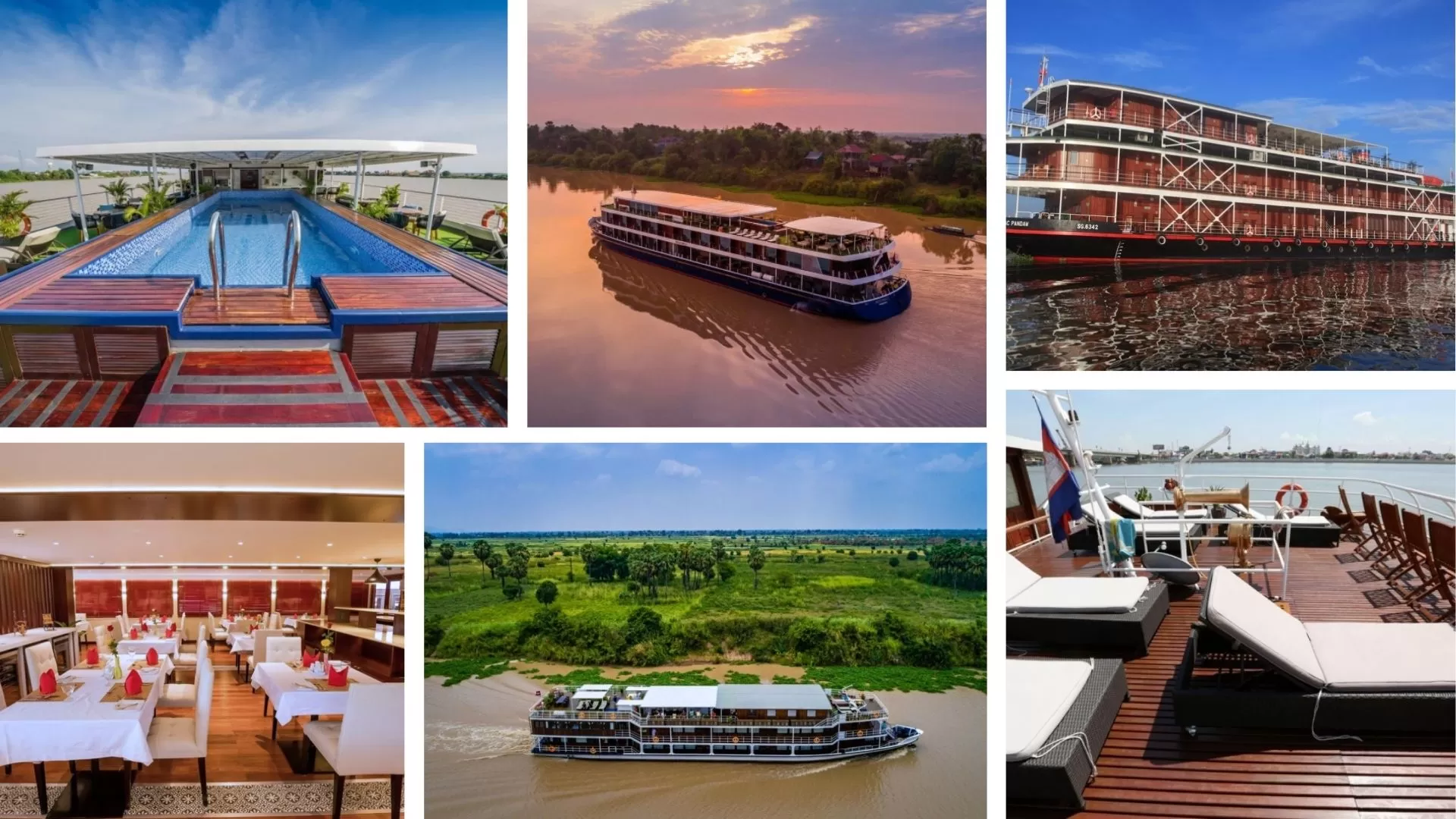
When planning your trip, this Vietnam travel guide recommends booking a hotel which is near tourist attractions. Some areas, such as Ho Chi Minh City and Hanoi, are bustling and offer easy access to attractions, while others, such as the countryside and smaller towns, offer a more peaceful experience.
You should also book a hotel in advance to ensure you have a place to stay. During peak travel season, hotels can fill up quickly, and you may have trouble finding a room if you arrive without a reservation. Booking a hotel in advance can also help you to secure a better rate, as prices may increase closer to the date of your arrival.
Hanoi Voyages will help you choose the right accommodations, from 2, 3, 4, and 5-star hotels to high-end resorts.
Generally, hotels have different room categories: standard, premium, and luxury. Hanoi Voyages has a very stringent criterion for selecting rooms, from location to service, to suit each customer’s travel experience.
If travelers want a local experience, Hanoi Voyages will help you book a homestay, which has minimal amenities but offers you the most authentic experience of our country.
Hanoi Voyages is partnering with many kinds of accommodation, from luxurious stays and boutique venues, to more affordable standard lodgings and cozy homestays, or elegant sea cruises, peaceful river cruises, in preparation for your exciting trip to Vietnam.
Safety and security for tourist when visiting Vietnam
Is Vietnam safe for visitors? Vietnam is generally considered a safe destination for foreign tourists. The country has hosted major international events, such as the 2019 US-North Korea summit, reflecting its stability. Travelers need not be overly concerned about issues like terrorism, violent crime, religious conflict, or sexual assault. Vietnam is widely regarded as a friendly and welcoming country for visitors.
Tips for staying safe in Vietnam (according to this Vietnam travel guide):
Watch out for petty crime: Pickpocketing and theft can occur, especially in crowded tourist areas. Keep valuables secure and avoid displaying them publicly.
Learn local customs and laws: Familiarizing yourself with local etiquette and regulations helps ensure a smooth and safe trip.
Be cautious with traffic: Roads can be chaotic, so exercise care when driving, riding a motorbike, or crossing streets. Always stay aware of your surroundings.
Top tourist destinations in Vietnam
Exploring Vietnam offers a wealth of experiences, from vibrant cities and historic landmarks to stunning natural landscapes. This Vietnam travel guide highlights the top tourist destinations across the country, helping you plan your itinerary and make the most of your journey through Vietnam’s diverse regions.
Hanoi - the capital of Vietnam
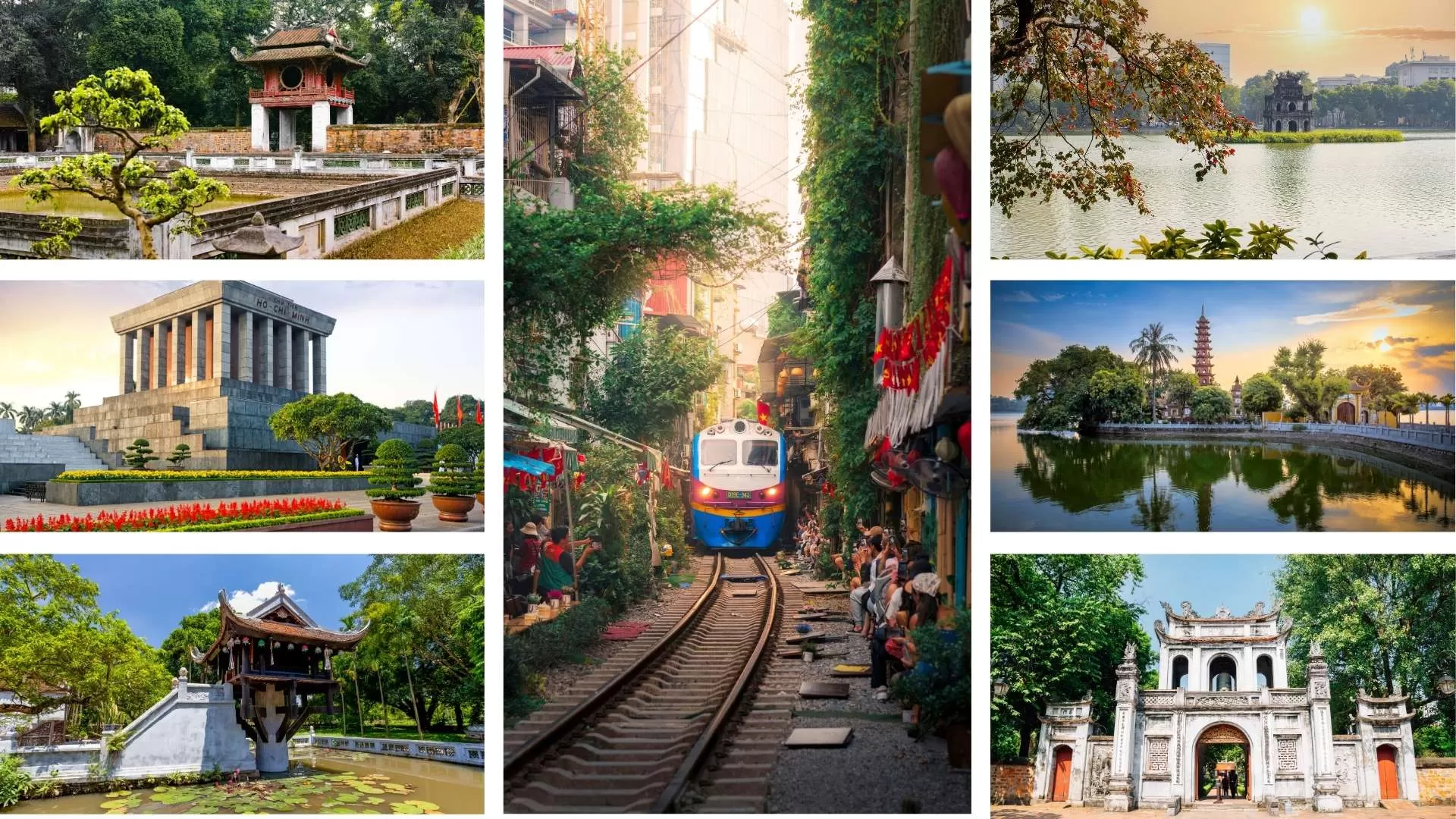
Hanoi is the capital city of Vietnam, located in the northern region of the country. It’s a vibrant and culturally rich city with a history that dates back over two thousand years. Hanoi is known for its stunning architecture, rich cultural heritage, delicious street food, and bustling nightlife. Follow this Vietnam travel guide to explore this capital's beauty!
When is the best time to visit Hanoi?
Hanoi has a tropical monsoon climate, when is the best time to visit Hanoi? It's hot and humid summers and cool, dry winters. The best time to visit from a weather perspective is from October to April, when the weather is mild and comfortable
What to do in Hanoi?
Visit Old Quarter: The Old Quarter is a historic neighborhood with narrow streets and traditional architecture, and it’s a great place to experience the city’s local culture and history.
Discover Vietnam’s history by visiting Ho Chi Minh Mausoleum: This mausoleum is dedicated to the late Vietnamese leader Ho Chi Minh and houses his preserved body. It’s a popular tourist destination and a symbol of national pride.
Visit Temple of Literature: The Temple of Literature is an ancient temple and Vietnam’s first university, built in the 11th century. Hanoi's temples are the beautiful example of Vietnamese architecture and a great place to learn about the country’s history.
See the famous Water Puppet Show: Get ready to be amazed by the traditional music and authentic Vietnamese operatic songs telling folktales and legends.
Enjoy Hanoi nightlife: Hanoi has a thriving and diverse nightlife, offering a range of options for those looking to enjoy the city after dark. Hanoi has a variety of bars and clubs to choose from, ranging from laid-back pubs to high-energy dance clubs. Some popular options include The Lush, The Bank and The Rooftop.
What to eat in Hanoi?
Hanoi offers a range of delicious and unique dishes that are a must-try for any food lover. Here are a few of the most popular and iconic foods to try in Hanoi:
Pho: Pho is a noodle soup that is considered one of the national dishes of Vietnam. It’s made with a flavorful broth, rice noodles, and a variety of toppings, such as beef or chicken.
Banh Mi: Banh Mi is a popular street food that consists of a baguette filled with a variety of ingredients, such as meat, vegetables, and sauces.
Bun Cha: Bun Cha is another popular noodle dish that consists of grilled pork, rice noodles, and a dipping sauce.
Cha Ca: Cha Ca is a Hanoi specialty that consists of grilled fish cooked with turmeric and dill, and served with noodles, herbs, and a flavorful dipping sauce
Egg Coffee: Egg coffee is a unique and delicious drink that is one of the best Hanoi's coffee. It’s made with a mixture of egg yolks, sugar, and condensed milk, and is typically served over hot coffee.
Hanoi Voyages will help you have an amazing experience when visiting Hanoi with the Vietnam tour 14 Days. We help you plan a schedule that fits your budget and optimizes your experiences while exploring Vietnam.
Ninh Binh - Halong Bay on land
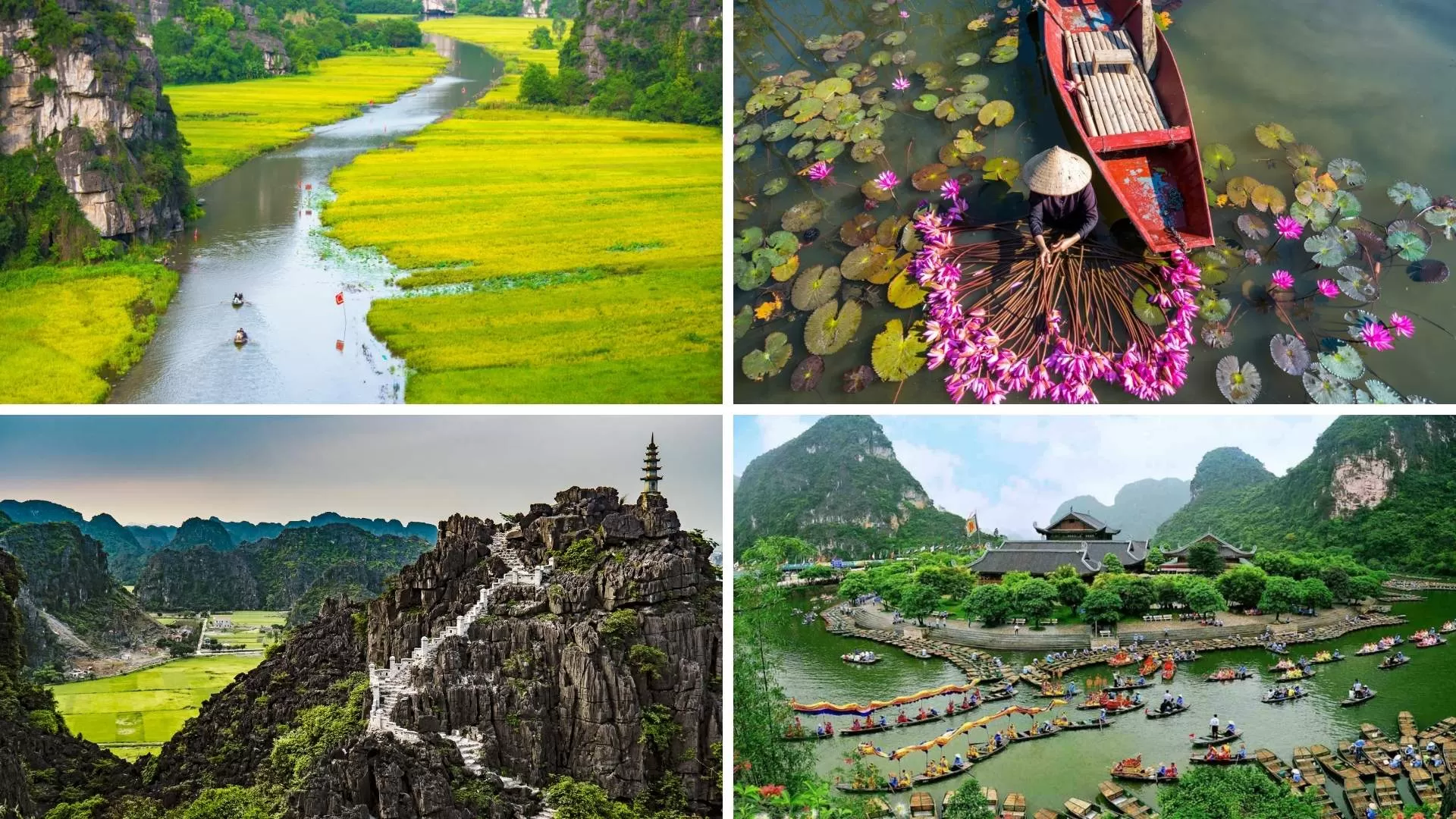
Ninh Binh is a city in northern Vietnam known for its stunning natural scenery and cultural heritage. Located approximately 90 km south of Hanoi, it is often referred to as the “Ha Long Bay on land ” due to its similar karst landscape of towering cliffs and lush green valleys. According to this Vietnam travel guide, Ninh Binh is a must-visit destination for travelers seeking both natural beauty and historical sites.
When is the best time to visit Ninh Binh?
Ninh Binh’s climate is typically humid subtropical with hot and rainy summers, contrasting its dry cold winters. Springs and autumns are not as defined, however.
The best time to visit Ninh Binh is from September to November, or from February to April. These months have the most favorable weather, with cool temperatures and little rain.
During the winter months from December to January, temperatures can get quite cold in Ninh Binh, especially at night, and there is a higher chance of rain. The summer months from May to August can be hot and humid, with more frequent rain showers.
What to do in Ninh Binh?
Visit Trang An Scenic Landscape Complex: This UNESCO World Heritage Site is a network of rivers and caves surrounded by towering limestone cliffs. Visitors can take a boat tour through the caves and admire the breathtaking scenery.
Visit Tam Coc: Tam Coc is a popular destination for visitors to Ninh Binh, known for its stunning karst landscapes and boat rides through three caves.
Board a sampan and navigate Ngo Dong River where limestone towers rise above rice fields. The river is also a popular spot for kayaking and canoeing, offering a unique and peaceful way to explore the region’s stunning scenery.
Bike to the Bich Dong Pagoda and climb the stairs carved into the rock walls. This Buddhist temple is located on a hill overlooking the stunning Tam Coc valley and is considered one of the most beautiful temples in Vietnam.
What to eat in Ninh Binh?
Goat meat hotpot (Lẩu dê): A hearty, flavorful hotpot made with tender goat meat, mushrooms, and a variety of fresh herbs and spices.
Ant egg sticky rice: Ant egg sticky rice (Xoi Trung Kien) is a unique dish found in certain parts of Vietnam, including the region of Ninh Binh. It is made with sticky rice that is mixed with tiny ant eggs and spices, then formed into small balls or wrapped in banana leaves and steamed. The dish is considered a specialty in northern Vietnam and is known for its unique flavor and texture.
Discover the serene beauty of Ninh Binh on North Vietnam tour 10 days
Halong Bay - UNESCO World Heritage
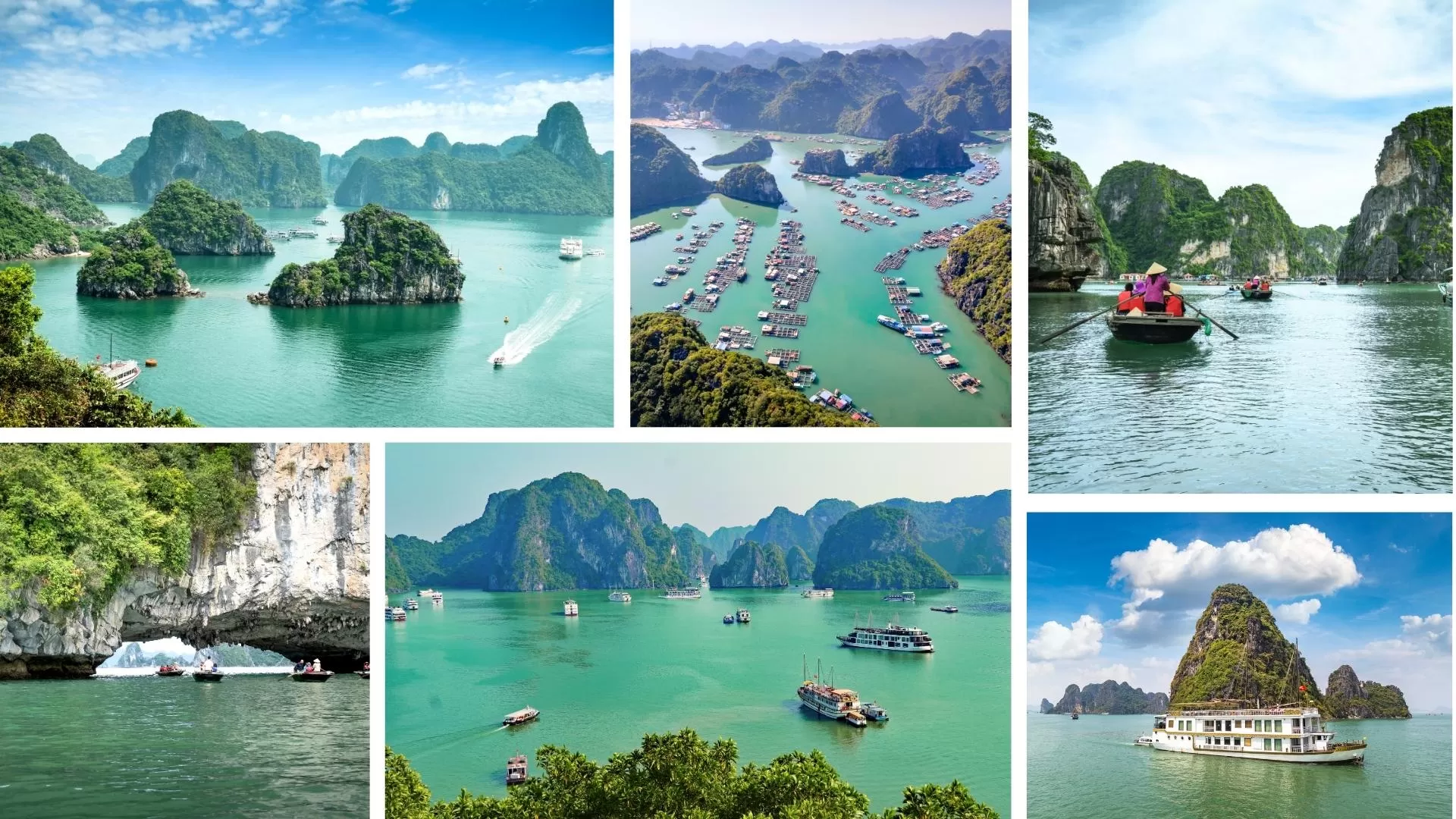
Ha Long Bay is a popular destination for tourists and offers a variety of activities, including boat tours, kayaking, cave exploring, and swimming. Visitors can also experience the local culture by visiting traditional floating villages or exploring the nearby islands.
When is the best time to visit Ha Long Bay?
The best time to visit Ha Long Bay is from December to February, when the weather is cool, dry, and sunny, offering clear views of the bay’s stunning scenery. LEARN MORE
What to do in Ha Long Bay?
According to this Vietnam travel guide, Ha Long Bay offers a wealth of experiences for travelers seeking both adventure and relaxation.
Experience the bay’s treasures and enjoy your time away from the crowd on a traditional wooden boat. The design and construction of the boat has naturally undergone some minor changes throughout the history, but you still can travel under their signature sails up to the present day.
Enjoy luxury cruise: Ha Long Bay cruise is a unique and unforgettable experience, offering travelers the chance to explore the stunning scenery of the bay from the comfort of a premium vessel. Luxury cruises in Ha Long Bay typically feature large, spacious cabins with modern amenities, gourmet dining options, and a range of recreational activities, including kayaking, fishing, and guided tours of the bay’s iconic islands and caves.
Adventure within the fantastically formed Thien Canh Son Cave and be fascinated by the formations of the bay: A visit to Thien Canh Son Cave is typically combined with a trip to Ha Long Bay and its many other attractions, including floating villages, island-studded waters, and stunning limestone formations. Whether you’re a nature lover, a history buff, or simply looking for a breathtaking escape, Thien Canh Son Cave is sure to provide you with an unforgettable experience.
Participate in kayaking, swimming or relax on the white sand beach of Hon Co Island. Visitors to Hon Co Island can enjoy a range of activities, including swimming, sunbathing, kayaking, and snorkeling. The island’s clear waters are home to a diverse range of marine life, making it an ideal destination for snorkeling and diving.
What to eat in Ha Long Bay?
Ha Long Bay is a popular tourist destination in Vietnam, and its vibrant local cuisine is an important part of the area’s culture and heritage. Visitors to Ha Long Bay can sample a range of delicious local dishes, including:
Oysters: Apparently, the most famous example of Ha Long cuisine. Fresh oysters are carefully washed and grilled. And pepper and lemon sauce, spring onions, chili and lemongrass add an extra boost of flavor.
Cha muc Ha Long: Otherwise known as “grilled chopped squid” or squid sausage or squid cake. The dish is made by marinating whole squid in a mixture of spices and sauces, then grilling it until it is tender and juicy. The grilled squid is then served with a dipping sauce made from chili sauce, sugar, and vinegar, creating a sweet and spicy flavor that compliments the tender, smoky squid.
Sa Sung – peanut worm Sa Sung: It is known for its crunchy texture and savory flavor, and it is often enjoyed with rice, dipping sauces, and vegetables. Some people find the flavor of Sa Sung to be similar to that of shrimp, while others describe it as nutty and slightly sweet. Whether you’re a fan of seafood or simply looking to try something new, Sa Sung is a unique and delicious dish that is definitely worth trying when visiting Ha Long Bay.
Discover stunning beaches and exciting activities on Vietnam tour 15 days beach extension
Hoi An - The ancient town
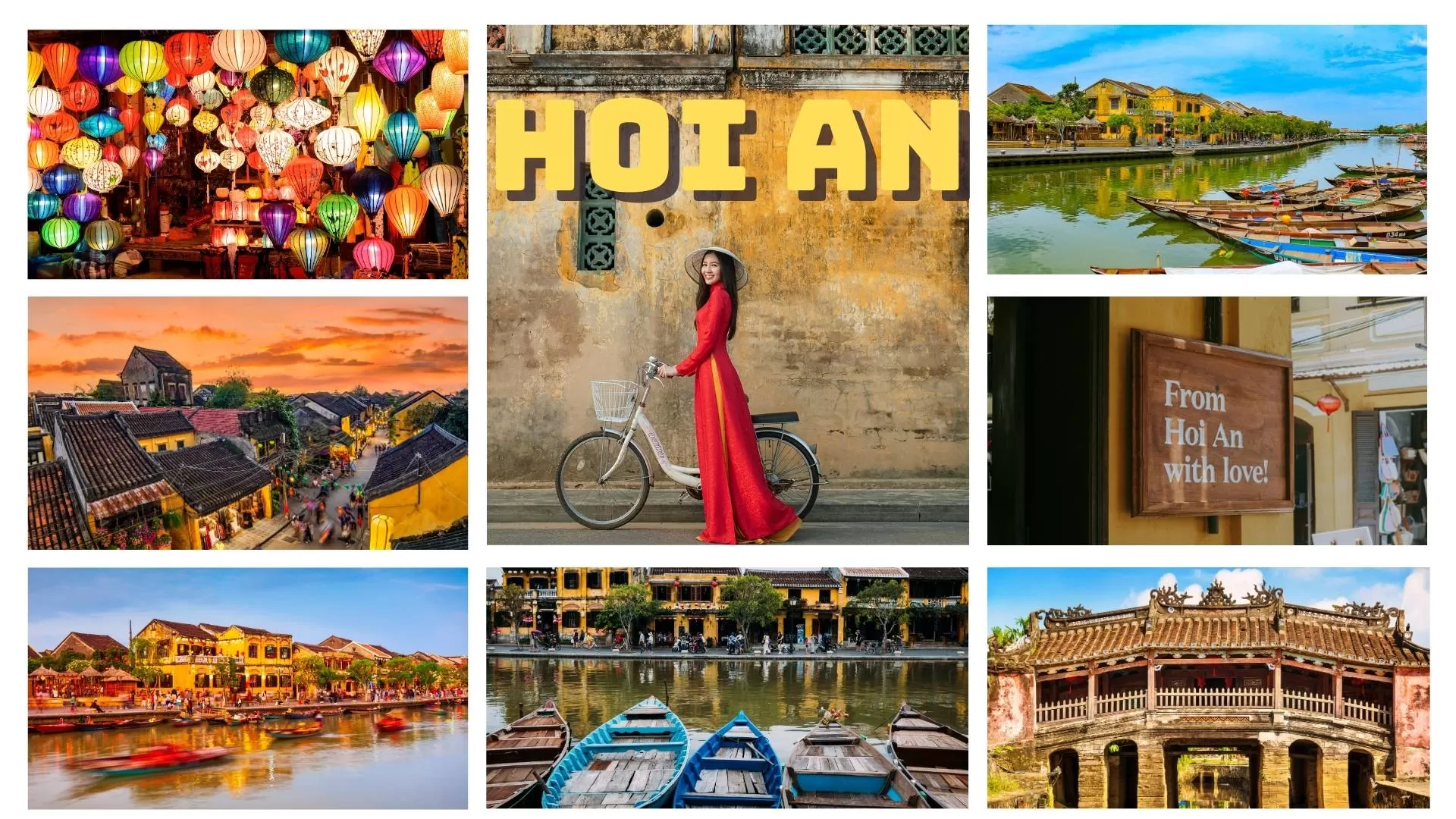
Hoi An is a unique and picturesque city located in central Vietnam, known for its ancient architecture, rich cultural heritage, and beautiful landscapes. One of the main attractions of Hoi An is its historic old town, which has been designated a UNESCO World Heritage Site. Visitors can explore the charming streets, shop for traditional crafts, and visit the ancient temples and pagodas.
When is the best time to visit Hoi An?
The best time to visit Hoi An is generally between February and April, when the weather is dry and sunny, and temperatures are pleasant. During these months, the skies are typically clear, making it a great time to explore the city’s ancient streets, take part in cultural activities, and relax on the nearby beaches.
Another good time to visit is from September to November, which is the tail-end of the rainy season and the beginning of the dry season. The weather is typically mild and there is less rainfall, making it a good time to explore the city’s outdoor attractions.
Avoid visiting Hoi An during the rainy season, which lasts from June to August, as the heavy rainfall and high humidity can make it uncomfortable to be outside for long periods of time.
What to do in Hoi An?
Stroll through the delightful trading port and see the remaining century-old buildings in Hoi An.
Explore the well-preserved ancient streets of Hoi An, visit historic buildings, and admire the colorful lanterns that light up the city at night. Appreciate the narrow alleys, charming homes with wooden balconies, fascinating architectural features, beautiful temples, and the famous Japanese Bridge.
Go to the beach: Relax on the nearby Cua Dai beach, go for a swim or participate in water sports.
Make your own lantern when visiting a lantern factory, which the city got famous for around the world. Making your own lantern at a lantern factory in Hoi An can be a fun and memorable experience. The process can take anywhere from 30 minutes to a couple of hours, depending on the complexity of the lantern design and your skill level. The staff at the factory will be able to guide you through the process and assist you with any questions you may have.
Learn about their traditional sedge mattress weaving. The weaving of sedge mattresses is a centuries-old tradition in Hoi An and has been passed down from generation to generation. The process involves weaving dried sedge plants into mats, which are then stuffed with cotton or bamboo to make comfortable and durable mattresses.
What to eat in Hoi An?
Cao Lau: Cao Lau is a traditional noodle dish from Hoi An, a city in central Vietnam. It is considered one of the city’s signature dishes and is known for its unique combination of flavors and textures. The dish is made with thick, chewy noodles made from rice flour and ash from the local Ba Na hills.
Com ga Hoi An: Com Ga Hoi An is a traditional chicken rice dish from Hoi An. It is considered one of the city’s signature dishes and is known for its unique flavor and presentation. The dish consists of tender and flavorful steamed or boiled chicken served over a bed of fragrant rice. The rice is flavored with turmeric, which gives it a yellow color, and is often mixed with diced onions, scallions, and other herbs. The chicken is typically seasoned with a blend of spices, including lemongrass, garlic, and ginger, and is served with a side of dipping sauce made from fish sauce, lime juice, and chili pepper.
Banh Mi: Banh Mi Hoi An is made with a baguette filled with a variety of ingredients, including grilled or roasted pork, pâté, pickled vegetables, fresh herbs, and a spread of mayonnaise or other sauces. The fillings are carefully balanced to create a harmonious combination of flavors, textures, and temperatures.
Hue - The Imperial City
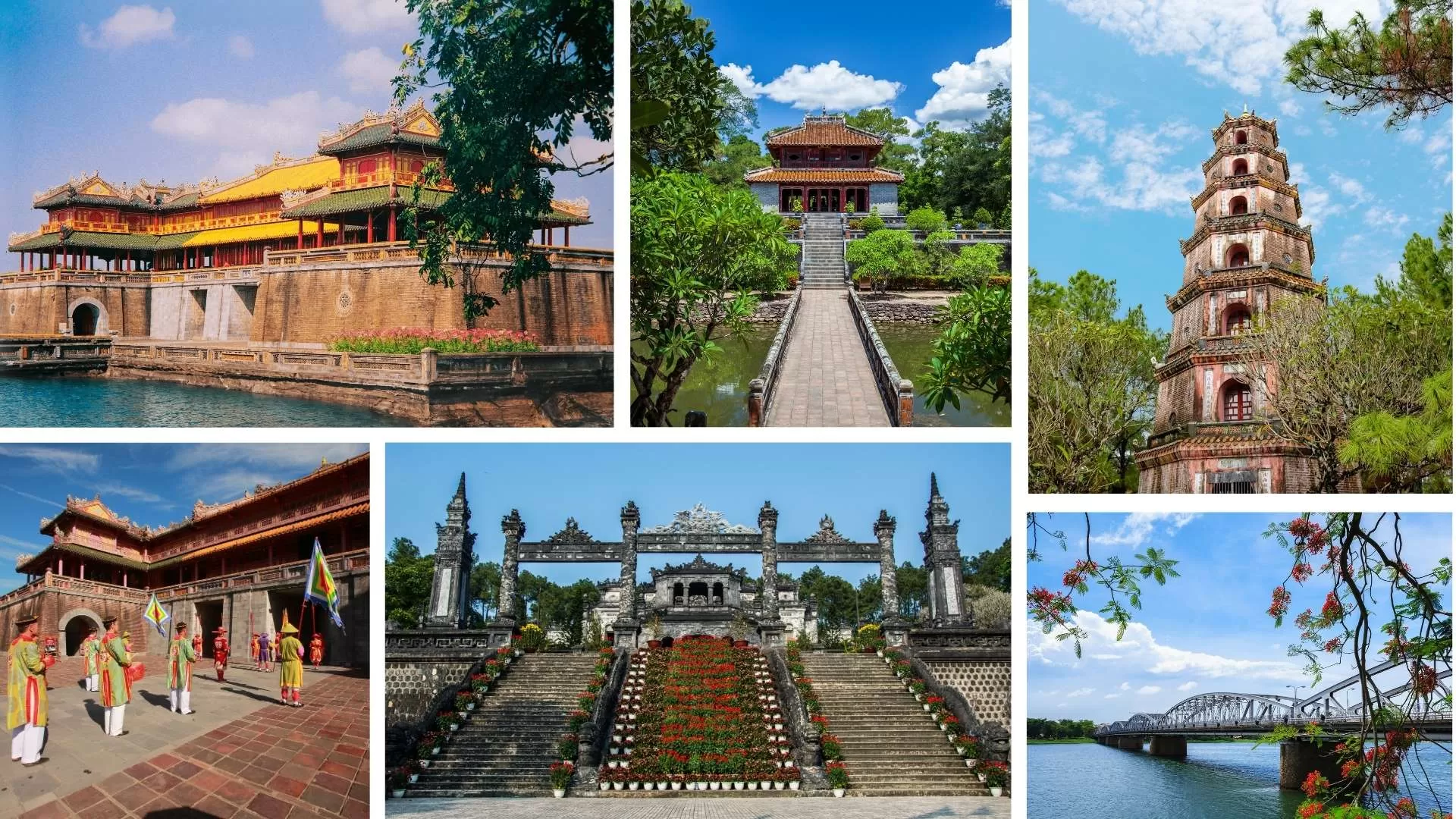
Hue is a city in central Vietnam, located on the banks of the Perfume River (Song Huong). It was once the capital of the Nguyen dynasty, the last feudal dynasty in Vietnamese history, and is considered one of the country’s cultural and historical centers.
When is the best time to visit Hue?
The dry season in Hue usually lasts from March to August. During this time, the weather is relatively dry and sunny, with low levels of precipitation and high temperatures. This period is characterized by clear skies, low humidity, and little to no rain, making it a popular time for outdoor activities and sightseeing.
Wet season in Hue is from September to March. The average temperature is about 18°C – 23°C.
Avoid September to December if possible, as this is the typhoon season.
What to do in Hue?
Hue is a city with a rich cultural and historical heritage, offering a wide range of activities and attractions for visitors. Here are some of the top things to do in Hue:
Visit the Imperial City: The Imperial City is a sprawling palace complex that was once the home of the Nguyen dynasty. Visitors can explore the complex’s many gates, courtyards, and temples, and visit the Forbidden Purple City, a private residence for the emperor and his family.
Visit the Imperial Tombs: Hue is home to several royal tombs of the Nguyen dynasty. Visitors can explore these historic sites to learn more about the city’s imperial history.
Explore the Thien Mu Pagoda: The Thien Mu Pagoda is a Buddhist temple that dates back to the 17th century. Visitors can climb the seven-storey tower for panoramic views of the city and the Perfume River, and visit the temple’s many shrines and gardens.
Visit Thanh Tien village:The village is famous for its traditional paper flower making, which has been passed down through generations of local artisans. Visitors to Thanh Tien Village can learn about the traditional paper flower making process, see the artisans at work, and purchase handmade paper flowers as souvenirs.
Visit the village of conical hats: As the name suggests, the village is famous for producing the iconic Vietnamese conical hat, known as Non La. Visitors to the village can observe the traditional hat-making process, watch the artisans at work, and purchase handmade conical hats as souvenirs.
What to eat in Hue?
Bun Bo Hue: Bun Bo Hue is considered one of the signature dishes of Hue, and is often considered a must-try for visitors to the city. The dish is typically served with rice noodles, slices of beef, and a variety of herbs and vegetables.
Com Hen: This is another of Hue speciality. It is made from baby mussels or basket clams and leftover rice. Com Hen is known for its flavorful and fragrant combination of ingredients, and is often enjoyed as a light and flavorful lunch or dinner option. The dish is typically served in a large bowl.
Rice cakes: There are many different varieties of rice cakes in Hue, including sweet and savory options, and they are often enjoyed as a snack or dessert. Some of the most popular types of rice cakes in Hue include banh beo, banh nam, and banh bot loc. Each one has a very special unique taste to it, so come to Hue and try them for yourself!
Discover some famous UNESCO sites with our Vietnam family tour 18 days
Ho Chi Minh City - Vietnam’s largest metropolis
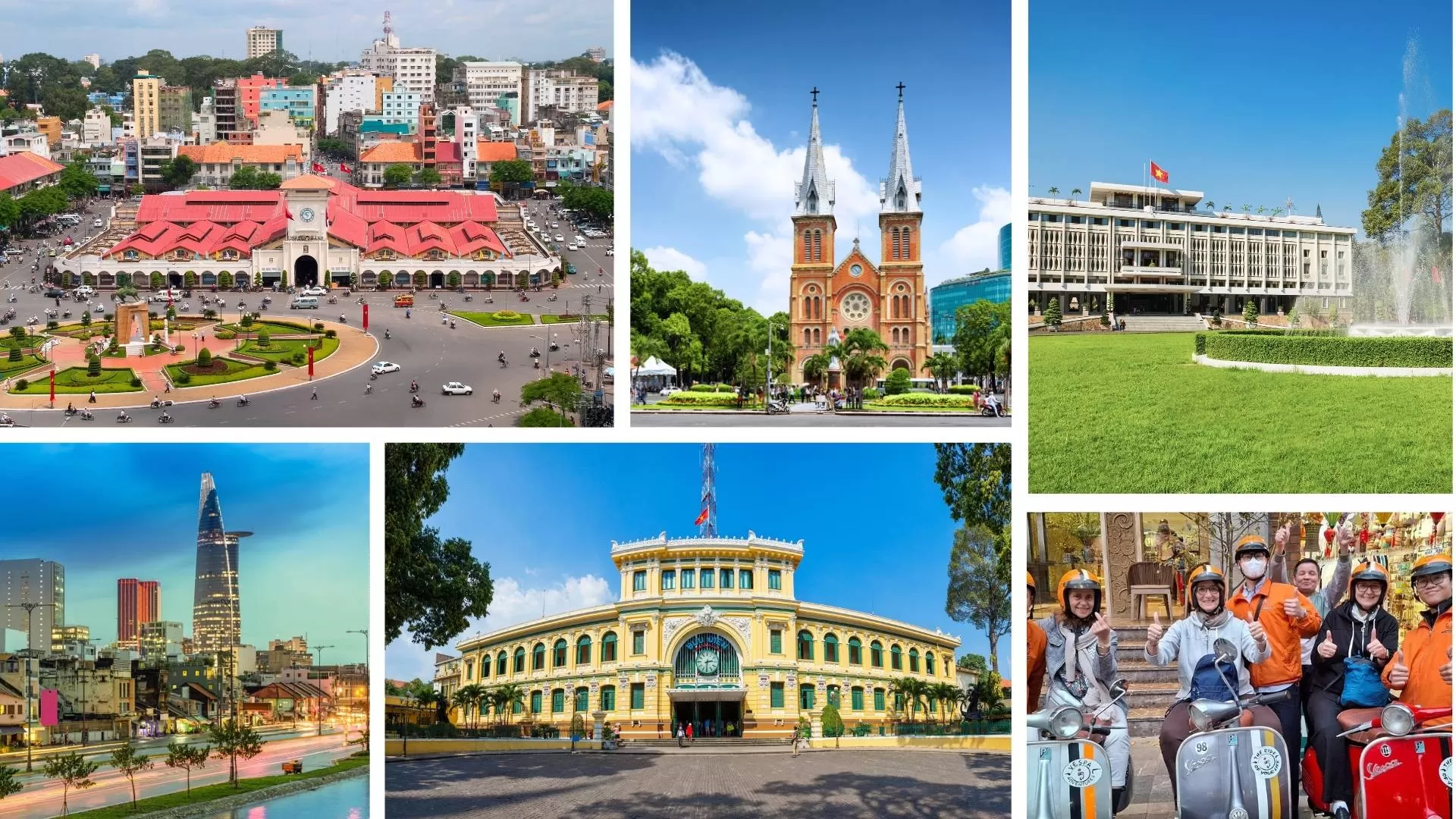
Ho Chi Minh city, also known as Saigon, is the largest city of Vietnam. It is located in the southeastern region of the country, and is known for its rich history, vibrant culture, and bustling economy.
When is the best time to visit Ho Chi Minh city?
There are two distinct seasons in Saigon: the Northwest Monsoon season from November to April and the Southwest rainy season from May to October.
The dry season, from November to April, is considered the best time to visit Ho Chi Minh City as the weather is relatively cool and pleasant, and there is less rainfall. However, this is also the peak tourism season, and the city can get crowded and prices may be higher.
The rainy season, from May to October, is characterized by high humidity and heavy rainfall, which can make outdoor activities less enjoyable.
What to do in Ho Chi Minh city?
Visit the War Remnants Museum: It is home to the history of locals’ perspectives of the American/Vietnam War. It was established in 1975, shortly after the end of the Vietnam War, to display artifacts and provide information about the conflict. The museum features exhibits on various aspects of the war, including the role of foreign countries, the suffering of the Vietnamese people, and the effects of chemical warfare.
Visit Binh Tay Market (Cholon Chinatown Market): This is a large indoor and outdoor market located in the heart of Ho Chi Minh City’s bustling Chinatown. The market is known for its vibrant atmosphere and offers a wide range of goods, from fresh produce and street food to textiles, jewelry, and souvenirs
Walk around Ben Thanh Market: If you want to buy any souvenirs or try local food, Ben Thanh market is the place to go. It is among the most famous things to do in Ho Chi Minh city. You can buy anything there, but do not forget to bargain! The market is massive and can seem overcrowded when you navigate through the small alleys
Visit the old Presidential Palace: where victory was declared after years of fighting and is preserved as found with vehicles still in the garages. Today, the Old Presidential Palace is open to the public as a museum, allowing visitors to explore the building and learn about its history and significance. The palace is notable for its unique architecture, which blends traditional Vietnamese design with modernist elements.
Experience Saigon’s nightlife: Jumping on the back of a Vespa with a qualified driver and experiencing Saigon’s nightlife the way locals do and trying out the best authentic local food and listening to live music at a Vietnamese coffee shop will be unforgettable experiences when you come to Saigon.
What to eat in Ho Chi Minh city?
Banh Mi: Banh Mi is a popular street food in Saigon and can be found at many street vendors, cafes, and restaurants throughout the city. It’s a quick and convenient option for those looking for a tasty and affordable meal on the go.
Bo Bia: Bo Bia is a type of Vietnamese spring roll that is popular in Ho Chi Minh City. The spring roll typically consists of a rice paper wrapper filled with a mixture of ingredients, such as cooked vermicelli noodles, julienned carrots, cucumber, and pork or shrimp.
Banh Trang Tron (Mixed Rice Paper Salad): Banh Trang Tron is a popular Vietnamese street food, also known as mixed rice paper salad. It is a mix of various ingredients such as shredded green mango, papaya, carrots, bean sprouts, Vietnamese coriander (Rau Ram), mint, roasted peanuts, and dried shrimp, all tossed together with a sweet and spicy dressing. This dish is a great option for a light and refreshing snack or meal.
Mekong Delta Region
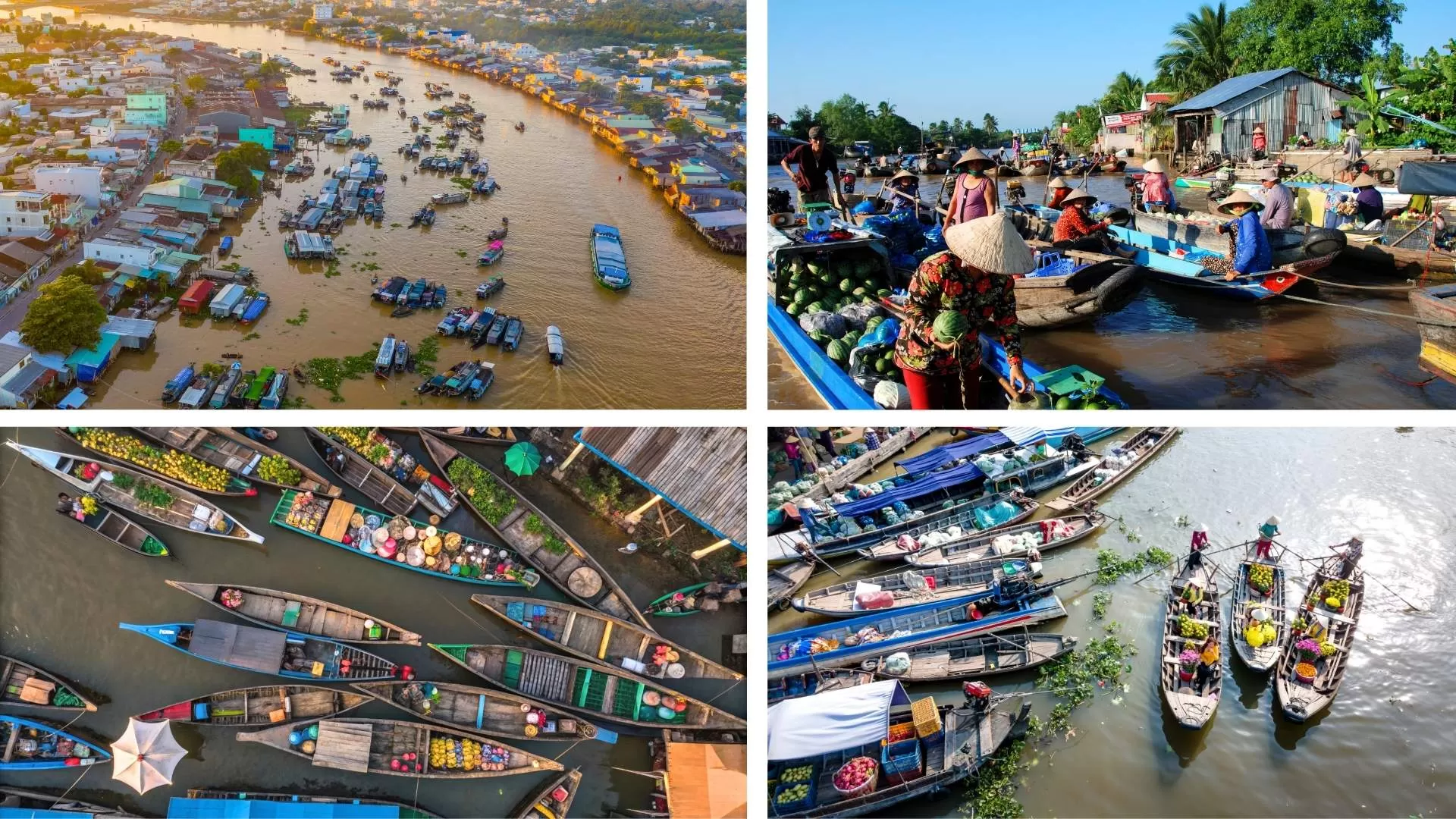
Are you fascinated by the idea of visiting a place where individuals reside on the river, run their eateries, and earn a living? Intrigued? Let’s go to the Mekong Delta River in the South of Vietnam and discover things that you have never seen in your life!
When is the best time to visit the Mekong Delta Region?
The best time to visit the Mekong Delta region in Vietnam is from December to April, when the weather is dry and pleasant. During this time, the weather is warm and sunny, making it the ideal time for outdoor activities and exploring the area’s waterways and villages. The rivers and canals are also less crowded during this time, allowing for a more peaceful and relaxed experience.
In the summer months of May to November, the region experiences monsoon rains, which can make it more difficult to travel and enjoy outdoor activities. The rivers and canals can become swollen and the weather can be hot and humid.
What to do in the Mekong Delta Region?
Explore waterways: Board the private boat and sail down narrow waterways on a local sampan and observe productive rice fields, fruit orchards, and historic buildings.
Travel to Can Tho: Can Tho is the largest town and trading center in Mekong Delta. It is known for its beautiful waterways, bustling markets, and rich history and culture. One of the most popular attractions in Can Tho is the Cai Rang floating market, which is a great place to sample local food and purchase goods from local farmers. Visitors can also explore the city’s traditional markets, such as Ninh Kieu wharf, and learn about the local way of life
Visit the 100-year-old Binh Thuy Ancient House: Visitors come here to appreciate the historic workmanship and architecture and admire the lush vegetation and active life of the local people along the riverbanks.
What to eat in the Mekong Delta Region?
The Mekong Delta region of Vietnam is known for its rich and diverse cuisine, reflecting the fertile land and abundant waterways. Here are some popular dishes to try when visiting the Mekong Delta:
Hu Tieu Nam Vang: A noodle dish originating from Phnom Penh, Cambodia, but widely enjoyed in the Mekong Delta, made with rice noodles, pork, shrimp, and a flavorful broth.
Rice Mouse: The endless rice fields of Mekong Delta is also the home to the rice mouse. Every year, after cultivation, local farmers can catch a lot of rice mice for a rather unusual feast. If you are concerned about possible diseases you may catch from the mouse, rest assured that the mouse eats fresh rice, not trash. Would you be willing to challenge yourself and try a taste of grilled rice mouse?
Roasted snakehead fish: This is the speciality of the whole region. It is not even difficult to cook it by yourself. All you need is a snakehead fish (obviously), some bamboo sticks and rice straws. Marinate the fish with spicy salt (or not, if you are not a fan of spicy foods) and herbs, then spear it with bamboo sticks, and roast with rice straws. The dish will come out with a special taste from rice straws, something you would never get in your hometown.
What to notice about Vietnam's culture and tradition
When visiting Vietnam, being mindful of its culture and traditions can greatly enrich your experience. This Vietnam travel guide provides essential insights into local customs, etiquette, and cultural practices, helping travelers navigate social interactions respectfully while fully appreciating the country’s vibrant heritage.
| Things you should know before traveling to Vietnam |
|
Vietnam is a land of breathtaking scenery, rich traditions, and unforgettable experiences. With the insights provided in this Vietnam travel guide, you’re ready to explore the country with confidence and curiosity. Don’t wait—start your journey now and discover the wonders of Vietnam for yourself!
Start planning your trip today and immerse yourself in the beauty, history, and flavors of Vietnam with Hanoi Voyages—you won’t want to miss a moment of this incredible destination!
Dream about your trip to Asia, in private
We are here to make it happen with youFREE QUOTE, WITHOUT OBLIGATION

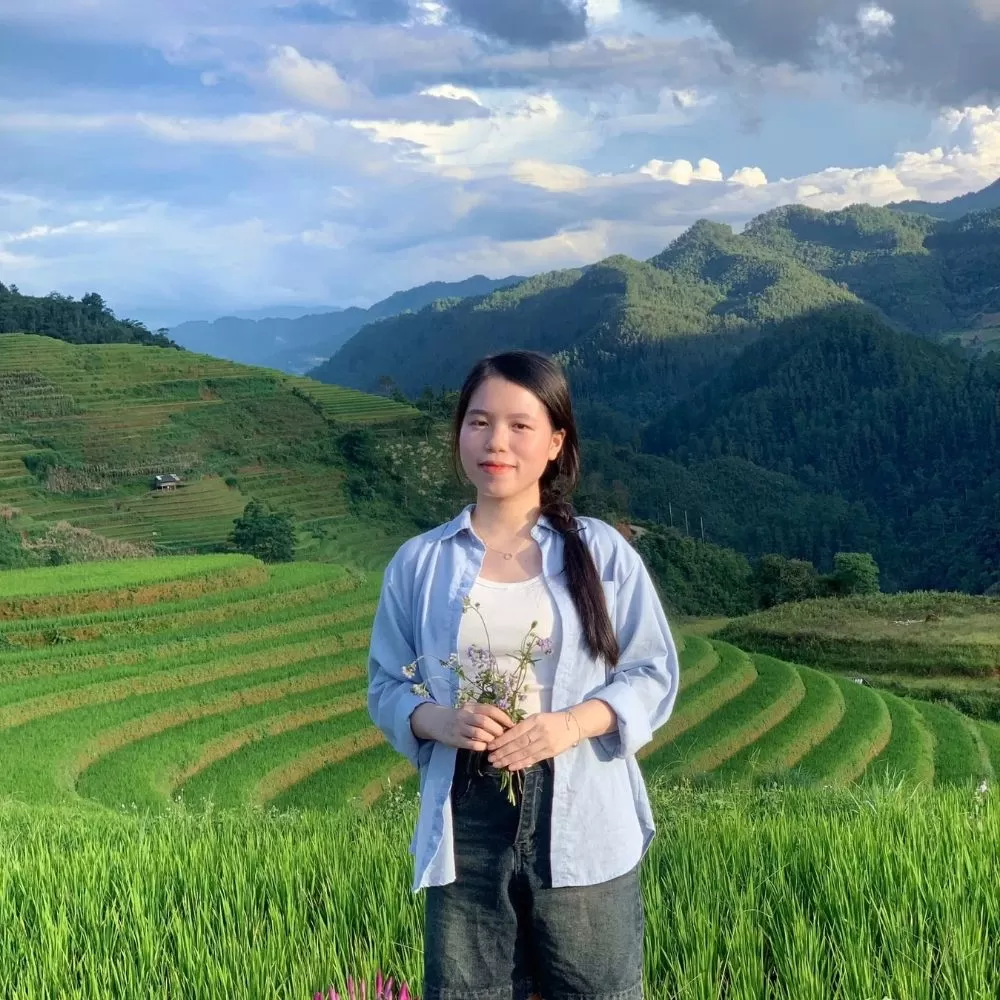






.webp)
